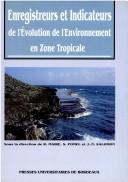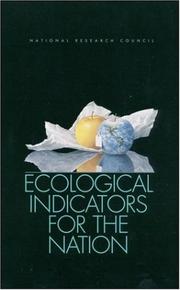| Listing 1 - 10 of 32 | << page >> |
Sort by
|
Book
ISBN: 8194281504 9788194281504 Year: 2020 Publisher: [Place of publication not identified] NIPA
Abstract | Keywords | Export | Availability | Bookmark
 Loading...
Loading...Choose an application
- Reference Manager
- EndNote
- RefWorks (Direct export to RefWorks)
water and weed management, cropping and farming system studies, meteorological and crop physiological studies and economic assessment of all the management techniques. Keeping these things in mind the entire book has been divided into ten chapteThe book has been written for teachers, students, researchers and policy makers and extension workers engaged in agricultural management research strategies.
Periodical
Abstract | Keywords | Export | Availability | Bookmark
 Loading...
Loading...Choose an application
- Reference Manager
- EndNote
- RefWorks (Direct export to RefWorks)
environmental management --- policy formulation --- sustainable development --- sdgs --- system resilience --- human health --- Environmental indicators --- Sustainability --- Environmental indicators. --- Sustainability. --- Sustainability science --- Human ecology --- Social ecology --- Ecological indicators --- Environmental indexes --- Environmental indices --- Indexes, Environmental --- Indicators, Environmental --- Indices, Environmental --- Environmental monitoring --- sustainable development goals
Book
ISBN: 1283155265 9786613155269 0643097139 9780643097131 9780643099432 0643099433 9780643090583 0643090584 9781283155267 Year: 2009 Publisher: Collingwood, VIC
Abstract | Keywords | Export | Availability | Bookmark
 Loading...
Loading...Choose an application
- Reference Manager
- EndNote
- RefWorks (Direct export to RefWorks)
A comprehensive introduction to the biology and ecology of plankton.
Plankton --- Indicators (Biology) --- Bioindicators --- Biological environmental indicators --- Biological indicators --- Ecological indicators --- Environmental indicators, Biological --- Sentinel organisms --- Ecology --- Biological monitoring --- Biological reagents --- Water quality biological assessment --- Plankton sampling --- Aquatic biology --- Ecology. --- Measurement.
Book
ISBN: 1486308805 9781486308804 9781486308798 1486308791 9781486308811 1486308813 9780367030162 0367030160 Year: 2019 Publisher: Clayton South VIC Boca Raton, Florida
Abstract | Keywords | Export | Availability | Bookmark
 Loading...
Loading...Choose an application
- Reference Manager
- EndNote
- RefWorks (Direct export to RefWorks)
Healthy waterways and oceans are essential for our increasingly urbanised world. Yet monitoring water quality in aquatic environments is a challenge, as it varies from hour to hour due to stormwater and currents. Being at the base of the aquatic food web and present in huge numbers, plankton are strongly influenced by changes in environment and provide an indication of water quality integrated over days and weeks. Plankton are the aquatic version of a canary in a coal mine. They are also vital for our existence, providing not only food for fish, seabirds, seals and sharks, but producing oxygen, cycling nutrients, processing pollutants, and removing carbon dioxide from our atmosphere. This Second Edition is a fully updated introduction to the biology, ecology and identification of plankton and their use in monitoring water quality. It includes expanded, illustrated descriptions of all major groups of freshwater, coastal and marine phytoplankton and zooplankton and a new chapter on teaching science using plankton. Best practice methods for plankton sampling and monitoring programs are presented using case studies, along with explanations of how to analyse and interpret sampling data. The book is an invaluable reference for teachers and students, environmental managers, ecologists, estuary and catchment management committees, and coastal engineers
Plankton --- Indicators (Biology) --- Bioindicators --- Biological environmental indicators --- Biological indicators --- Ecological indicators --- Environmental indicators, Biological --- Sentinel organisms --- Ecology --- Biological monitoring --- Biological reagents --- Water quality biological assessment --- Aquatic biology --- Ecology. --- Water quality --- Measurement --- Plankton - Ecology --- Plankton - Measurement --- Water quality - Measurement
Book
ISBN: 6074626251 9786074626254 9786074625226 6074625220 Year: 2014 Publisher: México, D.F. : El Colegio de México,
Abstract | Keywords | Export | Availability | Bookmark
 Loading...
Loading...Choose an application
- Reference Manager
- EndNote
- RefWorks (Direct export to RefWorks)
Environmental indicators. --- Environmental economics --- Estadísticas ambientales. --- Economía medioambiental. --- Mexico --- México --- Environmental conditions. --- Condiciones ambientales.


ISBN: 2867811570 9791030003857 Year: 2018 Publisher: Pessac : Presses Universitaires de Bordeaux,
Abstract | Keywords | Export | Availability | Bookmark
 Loading...
Loading...Choose an application
- Reference Manager
- EndNote
- RefWorks (Direct export to RefWorks)
Nombre d'économistes et de géographes contestent la pertinence des Sciences de la Nature dans les études de Développement. Pour beaucoup le concept de tropicalité n'a guère de réalité. Et pourtant la spécificité du monde intertropical est d'une évidence troublante : un "Monde sans hiver" (1993) du botaniste Francis HALLÉ vient de le rappeler avec bon sens. Le domaine tropical regroupe plus de 65 % de la population mondiale et la majorité des pays pauvres sur 40 % des terres émergées. La plupart des ressources fossiles (charbon, pétrole, métaux) se sont élaborées en conditions tropicales. Le monde tropical concerne donc tous les hommes. En privilégiant les études de terrain et l'intérêt des marqueurs de l'évolution des milieux, les auteurs montrent l'infinie variété des environnements tropicaux et des comportements. Mais la déstabilisation anthropique des milieux s'est accélérée au cours du XXe siècle. Sont mis en évidence les enregistreurs et les indicateurs des évolutions à court et à long terme : milieux de dépôts, indicateurs des sols et de la végétation, ressources en eau, crises climatiques et rurales, littoraux et montagnes. Cette vision résolument géographique et à long terne s'oppose à une vision économiste et à courte vue, imposée par le système financier mondial. La gestion de notre Environnement devrait-elle se soumettre aux stratégies de Développement comme le suggèrent certaines conclusions du Sommet de Rio ? L'homme a peu à peu domestiqué les paysages tropicaux, sans pour autant gommer leur spécificité. Notre environnement s'adapte en permanence, avec ou sans l'Homme, depuis des millions d'années. Si l'Homme veut conserver sa place, il ne doit pas se laisser entraîner par l'utopie d'un "possibilisme" régi par les intérêts immédiats des pays riches. Plus que jamais Environnement et Développement sont liés. En effet la croissance démographique des pays tropicaux et ses conséquences pour la survie de l'Humanité dépendront d'une gestion à long terme de…
Environmental indicators --- Ecological indicators --- Environmental indexes --- Environmental indices --- Indexes, Environmental --- Indicators, Environmental --- Indices, Environmental --- Environmental monitoring --- géographie --- climat --- impact anthropique --- géosystème --- environnement --- érosion --- milieu tropical


ISBN: 0309068452 0585256373 0309515548 9780585256375 9780309068451 0305068452 0309172470 Year: 2000 Publisher: Washington, D.C. : National Academy Press,
Abstract | Keywords | Export | Availability | Bookmark
 Loading...
Loading...Choose an application
- Reference Manager
- EndNote
- RefWorks (Direct export to RefWorks)
Environmental indicators, such as global temperatures and pollutant concentrations, attract scientists' attention and often make the headlines. Equally important to policymaking are indicators of the ecological processes and conditions that yield food, fiber, building materials and ecological "services" such as water purification and recreation.This book identifies ecological indicators that can support U.S. policymaking and also be adapted to decisions at the regional and local levels. The committee describes indicators of land cover and productivity, species diversity, and other key ecological processes--explaining why each indicator is useful, what models support the indicator, what the measured values will mean, how the relevant data are gathered, how data collection might be improved, and what effects emerging technologies are likely to have on the measurements. The committee reviews how it arrived at its recommendations and explores how the indicators can contribute to policymaking. Also included are interesting details on paleoecology, satellite imagery, species diversity, and other aspects of ecological assessment. Federal, state, and local decisionmakers, as well as environmental scientists and practitioners, will be especially interested in this new book.
Environmental monitoring. --- Indicators (Biology) --- Environmental Sciences and Forestry. Ecology --- Ecology (General) --- Indicators (Biology). --- Ecology (General). --- Biomonitoring (Ecology) --- Ecological monitoring --- Environmental quality --- Monitoring, Environmental --- Bioindicators --- Biological environmental indicators --- Biological indicators --- Ecological indicators --- Environmental indicators, Biological --- Sentinel organisms --- Measurement --- Monitoring --- Applied ecology --- Environmental engineering --- Pollution --- Ecology --- Biological monitoring --- Biological reagents --- Water quality biological assessment --- Environmental Monitoring --- Science
Book
ISBN: 1281072354 9786611072353 0080527973 Year: 2003 Publisher: Amsterdam ; Boston : Elsevier,
Abstract | Keywords | Export | Availability | Bookmark
 Loading...
Loading...Choose an application
- Reference Manager
- EndNote
- RefWorks (Direct export to RefWorks)
This book provides comprehensive single source coverage of bioindication/biomonitoring in the fields of ecology, ecotoxicology and environmental sciences; from the ecological basics to the effects of chemicals on the environment and the latest test strategies. Contributions by leading figures in ecology from around the world reflect the broad scope of current thinking and research, making this volume essential reading for informed professionals and students.
Indicators (Biology) --- Environmental monitoring. --- Biomonitoring (Ecology) --- Ecological monitoring --- Environmental quality --- Monitoring, Environmental --- Applied ecology --- Environmental engineering --- Pollution --- Bioindicators --- Biological environmental indicators --- Biological indicators --- Ecological indicators --- Environmental indicators, Biological --- Sentinel organisms --- Ecology --- Biological monitoring --- Biological reagents --- Water quality biological assessment --- Measurement --- Monitoring
Book
ISBN: 9780521514002 9781139206068 1139206060 1139031791 9781139031790 0521514002 9781139203074 9781139199452 1139199455 1107224152 9781107224155 1280484314 9781280484315 9786613579294 6613579297 1139205269 9781139205269 113920307X 9781139203074 1139201662 9781139201667 1139204483 9781139204484 Year: 2012 Publisher: Cambridge ; : Cambridge University Press,
Abstract | Keywords | Export | Availability | Bookmark
 Loading...
Loading...Choose an application
- Reference Manager
- EndNote
- RefWorks (Direct export to RefWorks)
"Integrating research into freshwater biodiversity and the role of keystone species, this fascinating book presents freshwater crayfish as representatives of human-exacerbated threats to biodiversity and conservation. It uses examples from these and other large decapod invertebrates to explore how communities function and are controlled, alongside the implications of human demands and conflicts over limited resources, notably the severe impacts on biodiversity. The discussion is structured around three key topics - the present situation of crayfish in world freshwater ecosystems, the applications of science to conservation management and knowledge transfer for successful crayfish management. It outlines the historic exploitation of crayfish, addressing the problems caused by invasive alien forms and explaining the importance of correct identification when dealing with conservation issues. Offering a global perspective on freshwater systems, the book ultimately highlights how the conservation of such large and long-lived species will help protect ecosystem quality in the future"--
Crayfish --- Freshwater biodiversity conservation. --- Indicators (Biology) --- Ecology. --- Bioindicators --- Biological environmental indicators --- Biological indicators --- Ecological indicators --- Environmental indicators, Biological --- Sentinel organisms --- Ecology --- Biological monitoring --- Biological reagents --- Water quality biological assessment --- Conservation of freshwater biodiversity --- Freshwater biodiversity --- Freshwater biological diversity conservation --- Aquatic biodiversity conservation --- Crawdaddies --- Crawdads --- Crawfish --- Crawfishes --- Crayfishes --- Decapoda (Crustacea) --- Astacology --- Conservation
Book
ISBN: 3035700664 9783035700664 3038355917 9783038355915 Year: 2015 Publisher: Pfaffikon, Switzerland Trans Tech Publications Ltd
Abstract | Keywords | Export | Availability | Bookmark
 Loading...
Loading...Choose an application
- Reference Manager
- EndNote
- RefWorks (Direct export to RefWorks)
Biomineralization. --- Biomedical materials. --- Indicators (Biology) --- Bioindicators --- Biological environmental indicators --- Biological indicators --- Ecological indicators --- Environmental indicators, Biological --- Sentinel organisms --- Ecology --- Biological monitoring --- Biological reagents --- Water quality biological assessment --- Bioartificial materials --- Biocompatible materials --- Biomaterials --- Hemocompatible materials --- Medical materials --- Medicine --- Biomedical engineering --- Materials --- Biocompatibility --- Prosthesis --- Biological mineralization --- Mineralization, Biological --- Minerals in the body --- Biomineralization --- Biomedical materials --- Biomaterials (Biomedical materials)
| Listing 1 - 10 of 32 | << page >> |
Sort by
|

 Search
Search Feedback
Feedback About UniCat
About UniCat  Help
Help News
News